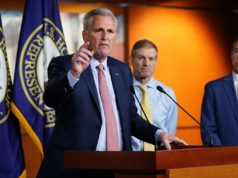Despite a recent reduction of cargo backlogs at our nation’s busiest ports, domestic supply chains remain stressed. Experts argue a tumultuous labor market, spurred by record turnover is a key contributor.
U.S. freight railroads, a critical connector in the supply chain, have not been spared from these challenges. Insufficient manpower is straining rail service, which railroads acknowledge must improve and are working to address — particularly through financial incentives and training programs to recruit new workers.
Yet, some see this tumult as an opportunity to pin not only macroeconomic challenges like inflation narrowly on railroads, but also to advance misguided policies as a cure-all to improve matters. The opposite is true: new regulations that complicate operations will potentially exacerbate disruptions over time.
In doing so, policymakers would be choosing a handful of powerful shipping groups over broad constituencies, including workers, environmentalists, other customers and passenger railroads.
Most troubling is an arcane but no less far-reaching battle over how freight traffic is “switched,” originally a topic of a White House executive order and recently the focus of a hearing at the Surface Transportation Board, or STB, a small but important agency.
Switching is when one freight railroad hands off responsibility for hauling railcars to another freight railroad. Railroads, which own and maintain their own networks through some $24 billion in annual spending of their own capital, already switch traffic where it makes sense economically and logistically. This is negotiated privately.
The fewer switches the better — it reduces the likelihood for clogging the network.
But under the guise of competition and more recently inflation and service challenges, policymakers are pondering a scheme to force more switches between railroads, which some erroneously argue will improve service and lower costs. Railroads could be forced to carry traffic for a competitor. Worse still, part of this would be done through overt rate regulation.
Yet a wealth of analysis from reputable economists shows that a forced switching paradigm would slow the movement of goods, reduce investment, raise costs for many customers, add unnecessary worker risk and ultimately shift freight to more carbon-intensive transportation like trucks. On-time-performance of passenger and commuter railroads in cities could suffer in the process too.
Today’s railroads are a cost-effective transportation mode in terms of combatting inflationary pressures. Average rail rates are down 44 percent since partial economic rail deregulation when accounting for inflation. While true that the producer price index shows that freight railroad rates have increased 20.3 percent over five years, this is far below price increases seen in competing modes of transportation, particularly long-distance trucking — up 46.8 percent in that same period.
Given rail’s environmental profile, many worry new regulation could also undermine climate goals. “Should any new regulation cause new bottlenecks, which the Biden administration and the rail industry are already working together to alleviate, freight could shift to more carbon-intensive modes of transportation,” says a letter signed by the nation’s oldest environmental organization.
Moreover, 91 Republican and 39 Democratic members of the House of Representatives urged caution at the STB, while a range of President Biden’s bedrock supporters also have voiced serious concerns. Opposition to switching regulation is broad and diverse, ranging from county commissioners to state senators, from libertarians to neoliberals, and small railroads to the intermodal industry.
“The proposal would discourage future investment by directly reducing the industry’s resources for investment and creating new uncertainty about the returns on investments at single-service facilities,” says Robert Shapiro, an economic advisor to Presidents Clinton and Obama,
The entire debate raises a serious question: why are some policymakers doing the narrow bidding of powerful forces at the expense of their topline goals related to climate change and the supply chain? The answer appears to be that rent seeking — or manipulation of public policy to increase profits — can be successful.
Railroads are working to improve service and transparency. They are deploying additional power where appropriate, increasing communication with customers, repositioning crews to high-density corridors and leveraging technology as needed to reduce dwell times. Progress will take time, including in hiring new workers, but new regulation is counter to progress.
Jefferies is president and CEO of the Association of American Railroads







